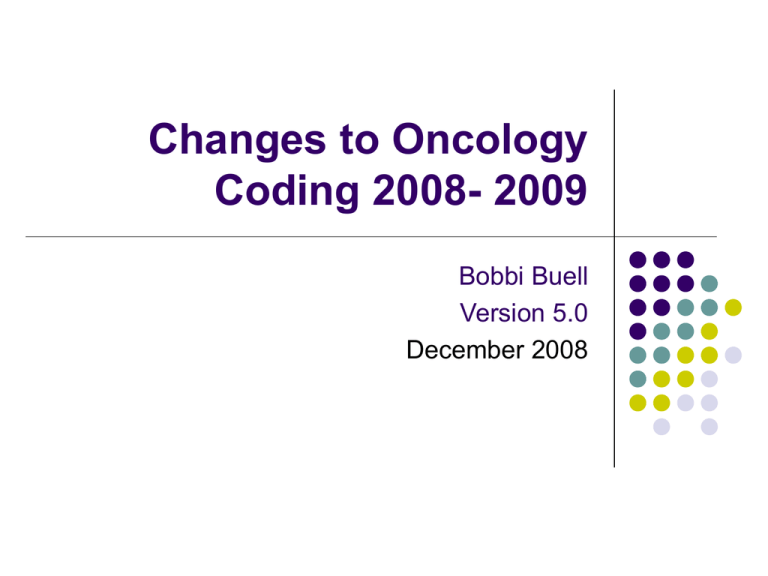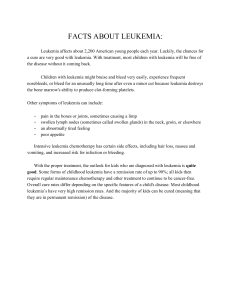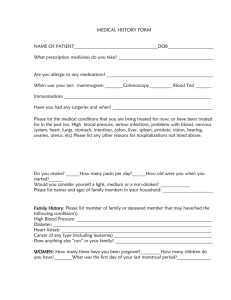
Changes to Oncology
Coding 2008- 2009
Bobbi Buell
Version 5.0
December 2008
Disclaimer
Payers differ on their guidelines. Please verify coding for
each payer and claim.
This is not legal or payment advice.
This content is abbreviated for Medical Oncology. It does not
substitute for a thorough review of code books, regulations,
and Carrier guidance.
This information is good for the date of the information and
may contain typographical errors.
CPT is the trademark for the American Medical Association.
All Rights Reserved.
Session Objectives
Discuss ICD-9-CM Changes for 2009
Discuss CPT Changes for 2009
Discuss HCPCS Coding for 2009
Discuss ESA Coding Now
Discuss Coding for PQRI 2009
Discuss Coding for E-Prescribing 2009
Review some E/M Changes for 2008
Review Consult Coding
Discuss What You Need to Do Next
General References
Physician Payment Rule =
http://www.cms.hhs.gov/PhysicianFeeSched/PFSFR
N/list.asp#TopOfPage
Hospital Outpatient Rule =
http://www.cms.hhs.gov/HospitalOutpatientPPS/HO
RD/list.asp#TopOfPage
ICD-9-CM Codes =
http://www.cms.hhs.gov/ICD9ProviderDiagnosticCod
es/07_summarytables.asp#TopOfPage
Coding Issues
Cancer ICD-9-CM Codes
10/1/08
199.2 Malignant neoplasm associated with transplant organ
203.02 Multiple myeloma, in relapse
203.12 Plasma cell leukemia, in relapse
203.82 Other immunoproliferative neoplasms, in relapse
204.02 Acute lymphoid leukemia, in relapse
204.12 Chronic lymphoid leukemia, in relapse
204.22 Subacute lymphoid leukemia, in relapse
204.82 Other lymphoid leukemia, in relapse
204.92 Unspecified lymphoid leukemia, in relapse
205.02 Acute myeloid leukemia, in relapse
205.12 Chronic myeloid leukemia, in relapse
205.22 Subacute myeloid leukemia, in relapse
205.32 Myeloid sarcoma, in relapse
205.82 Other myeloid leukemia, in relapse
205.92 Unspecified myeloid leukemia, in relapse
206.02 Acute monocytic leukemia, in relapse
206.12 Chronic monocytic leukemia, in relapse
206.22 Subacute monocytic leukemia, in relapse
206.82 Other monocytic leukemia, in relapse
206.92 Unspecified monocytic leukemia
Cancer ICD-9-CM Codes
10/1/08
207.02 Acute erythremia and erythroleukemia, in relapse
207.12 Chronic erythremia, in relapse
207.22 Megakaryocytic leukemia, in relapse
207.82 Other specified leukemia, in relapse
208.02 Acute leukemia of unspecified cell type, in relapse
208.12 Chronic leukemia of unspecified cell type, in relapse
208.22 Subacute leukemia of unspecified cell type, in relapse
208.82 Other leukemia of unspecified cell type, in relapse
208.92 Unspecified leukemia, in relapse
Cancer ICD-9-CM Codes
10/1/2008
209.00 Malignant carcinoid tumor of the small intestine, unspecified portion
209.01 Malignant carcinoid tumor of the duodenum
209.02 Malignant carcinoid tumor of the jejunum
209.03 Malignant carcinoid tumor of the ileum
209.10 Malignant carcinoid tumor of the large intestine, unspecified portion
209.11 Malignant carcinoid tumor of the appendix
209.12 Malignant carcinoid tumor of the cecum
209.13 Malignant carcinoid tumor of the ascending colon
209.14 Malignant carcinoid tumor of the transverse colon
209.15 Malignant carcinoid tumor of the descending colon
209.16 Malignant carcinoid tumor of the sigmoid colon
209.17 Malignant carcinoid tumor of the rectum
209.20 Malignant carcinoid tumor of unknown primary site
209.21 Malignant carcinoid tumor of the bronchus and lung
209.22 Malignant carcinoid tumor of the thymus
209.23 Malignant carcinoid tumor of the stomach
209.24 Malignant carcinoid tumor of the kidney
209.25 Malignant carcinoid tumor of foregut, not otherwise specified
209.26 Malignant carcinoid tumor of midgut, not otherwise specified
209.27 Malignant carcinoid tumor of hindgut, not otherwise specified
209.29 Malignant carcinoid tumor of other sites
New Cancer ICD-9 Codes
10/1/2008
209.30 Malignant poorly differentiated neuroendocrine carcinoma, any site
238.77 Post-transplant lymphoproliferative disorder (PTLD)
289.84 Heparin-induced thrombocytopenia (HIT)
999.81 Extravasation of vesicant chemotherapy
999.82 Extravasation of other vesicant agent
999.88 Other infusion reaction
999.89 Other transfusion reaction
V07.51 Prophylactic use of selective estrogen receptor modulators (SERMs)
V07.52 Prophylactic use of aromatase inhibitors
V07.59 Prophylactic use of other agents affecting estrogen receptors and estrogen levels
V13.51 Personal history of pathologic fracture
V87.41 Personal history of antineoplastic chemotherapy
V87.42 Personal history of monoclonal drug therapy
V87.49 Personal history of other drug therapy
Other ICD-9-CM Changes
Secondary Diabetes Mellitus (249.xx)
New types of headaches (339.xx)
A gaggle of new PAP and anal smear codes
(795.xx-796.xx)
V87.xx for exposure to toxic (and potentially
carcinogenic) substances
Funniest 2009 ICD-9-CM Codes
339.43 Primary Thunderclap Headache
339.82 Headache Associated With Sexual Activity
339.85 Primary Stabbing Headache
372.74 Pingueculitis
611.81 Ptosis of Breast
Changed Codes of Note
203.00 Multiple myeloma, without mention of having achieved remission
203.10 Plasma cell leukemia, without mention of having achieved remission
203.80 Other immunoproliferative neoplasms, without mention of having achieved
remission
204.00 Acute lymphoid leukemia, without mention of having achieved remission
204.10 Chronic lymphoid leukemia, without mention of having achieved remission
204.20 Subacute lymphoid leukemia, without mention of having achieved remission
204.80 Other lymphoid leukemia, without mention of having achieved remission
204.90 Unspecified lymphoid leukemia, without mention of having achieved remission
205.00 Acute myeloid leukemia, without mention of having achieved remission
205.10 Chronic myeloid leukemia, without mention of having achieved remission
205.20 Subacute myeloid leukemia, without mention of having achieved remission
205.30 Myeloid sarcoma, without mention of having achieved remission
205.80 Other myeloid leukemia, without mention of having achieved remission
205.90 Unspecified myeloid leukemia, without mention of having achieved remission
Changed Codes of Note (2009)
206.00 Acute monocytic leukemia, without mention of having achieved remission
206.10 Chronic monocytic leukemia, without mention of having achieved remission
206.20 Subacute monocytic leukemia, without mention of having achieved remission
206.80 Other monocytic leukemia, without mention of having achieved remission
206.90 Unspecified monocytic leukemia, without mention of having achieved remission
207.00 Acute erythremia and erythroleukemia, without mention of having achieved
remission
207.10 Chronic erythremia, without mention of having achieved remission
207.20 Megakaryocytic leukemia, without mention of having achieved remission
207.80 Other specified leukemia, without mention of having achieved remission
207.20 Megakaryocytic leukemia, without mention of having achieved remission
207.80 Other specified leukemia, without mention of having achieved remission \
208.00 Acute leukemia of unspecified cell type, without mention of having achieved remission
208.10 Chronic leukemia of unspecified cell type, without mention of having achieved remission
208.20 Subacute leukemia of unspecified cell type, without mention of having achieved remission
208.80 Other leukemia of unspecified cell type, without mention of having achieved remission
208.90 Unspecified leukemia, without mention of having achieved remission
V45.71 Acquired absence of breast and nipple
CPT Changes 2009
CPT decided to ‘go green this year and
changed the numbering for the Hydration and
Therapeutic codes so they are in the same
section as the Chemo codes.
All Hydration and Therapeutic codes will be “963”
codes instead of “907” codes.
90761 = 96361
90767 = 96367
90772 = 96372
ETC.
Source: CPT 2009
Crosswalk available at http://www.asco.org
CPT Changes 2009
The Chemotherapy Section name has
changed to “Chemotherapy or Highly
Complex Drug or Highly Complex Biologic
Agent” Administration
The word “highly complex” used with frequency
Will payers change admin codes on some drugs?
CMS leaves this up to the MACs and Carriers.
Other payers may be more strict with drug
administration, but let’s wait and see what the
AMA says.
Descriptor Source: CPT 2009
HCPCS Changes 2009
(1/1/2009)
New Codes:
J0641
J1267
J1453
J1459
INJECTION, LEVOLEUCOVORIN CALCIUM, 0.5 MG
INJECTION, DORIPENEM, 10 MG
INJECTION, FOSAPREPITANT, 1 MG
INJECTION, IMMUNE GLOBULIN (PRIVIGEN), INTRAVENOUS, NON-LYOPHILIZED (E.G.
HCPCS Changes
New Codes
J8705 TOPOTECAN, ORAL, 0.25 MG
J9033 INJECTION, BENDAMUSTINE HCL,
1 MG
J9207 INJECTION, IXABEPILONE, 1 MG
J9330 INJECTION, TEMSIROLIMUS, 1 MG
HCPCS Changes
Changed Descriptors
J1572 INJECTION, IMMUNE GLOBULIN,
(FLEBOGAMMA/FLEBOGAMMA
DIF), INTRAVENOUS,
J2788 INJECTION, RHO D IMMUNE
GLOBULIN, HUMAN, MINIDOSE, 50
MICROGRAMS (250 I.U.)
J2790 INJECTION, RHO D IMMUNE
GLOBULIN, HUMAN, FULL DOSE,
300 MICROGRAMS (1500 I.U.)
HCPCS
Deleted Codes
Q4097 INJECTION, IMMUNE GLOBULIN
(PRIVIGEN), INTRAVENOUS, NONLYOPHILIZED (E.G.
Q4098 INJECTION, IRON DEXTRAN, 50
MG
• They
reinstated
J1750
INJECTION, IRON DEXTRAN, 50
MG
MIPPA Legislation - PQRI
The Medicare Improvements for Patients and
Providers Act (MIPPA), passed in July 2008,
contained several new authorities and
requirements for quality reporting and PQRI
for 2009 and beyond.
Section 131 directly impacts PQRI
Section 132 contains the new electronic
prescribing incentive provisions.
MIPPA Legislation – PQRI, Section
131
PQRI 2009 incentive provided and raised to 2%
Eligible professionals shall be paid 2% incentive of
estimated allowable charges submitted not later than 2
months after the end of the reporting period for 2009
quality measures.
Adds qualified audiologists in the definition of
eligible professionals.
No effect on 2007 or 2008 incentive payments.
Registries
CMS received over 55 self-nomination requests for
registries to become “qualified” to submit quality
data for possible incentive payment on behalf of
their clients.
32 registries have been selected for “production”
(eligible to earn a payment incentive for their
providers)
The final list of “qualified” registries is posted on the
PQRI website at:
http://www.cms.hhs.gov/PQRI/20_Reporting.asp#To
pOfPage and go to the first download (“2008 List of
Qualified Registries”)
Registries
Becoming a “qualified” registry is not a
guarantee by CMS that the registry will be
successful submitting data on behalf of their
clients.
These registries, however, have gone
through a complete evaluation of their
measure calculations and a test that their
system can successfully communicate with
our data warehouse.
6 Registry-Based Options
Reporting Period:
January 1, 2008 December 31, 2008
Reporting Period:
July 1, 2008 –
December 31, 2008
Individual Measures:
80% of applicable cases
Minimum 3 measures
Individual Measures:
80% of applicable cases
Minimum 3 measures
One Measures Group:
30 consecutive patients
OR
80% of applicable cases
One Measures Group:
15 consecutive patients
OR
80% of applicable cases
Do You Want to Use a
Registry?
Must be a registered registry with CMS and
approved for submission.
Must successfully report in 2008. This can
be a mystery right now. Not really known until
after 3/31/2009.
May charge you, so is it cheaper than doing it
claim by claim?
Hematology-Oncology
Measures 2009
MDS And Acute Leukemias Cytogenetic Testing
MDS Documentation of Iron Stores
Multiple Myeloma: Treatment With Bisphosphonates
CLL Baseline Flow Cytometry
Hormonal Therapy for Stage IC-III ER/PR + Breast Cancer
Chemotherapy for Stage III Colon Cancer Patients
Breast Cancer Patients Who Have pT and pN category and histological grade for their cancer
Colorectal Cancer Patients Who Have pT and pN category and histological grade for their cancer
Inappropriate use of bone scan for staging low risk cancer patients
Adjuvant hormonal therapy for high-risk prostate cancer patients
Three-dimensional radiotherapy for patients with prostate cancer.
Melanoma: Follow Up Aspects of Care (2009)
Melanoma: Continuity of Care (2009)
Melanoma: Coordination of Care (2009)
Oncology Med/Rad: Plan of Care for Pain (2009)
Oncology Med/Rad: Pain Quantified (2009)
Oncology: Radiation Dose Limits to Normal Tissues (2009)
Oncology Recording of Clinical Stage for Lung and Esophageal Cancer (2009)
Notice #73 and #74 are gone
PQRI Coding 2008 (until
12/31/08)
Coding Example--Measure #71 Hormonal Therapy for Stage IC-III. ER/PR + Breast CA
Report once per reporting period for all females 18 and over having breast cancer seen during the
reporting period.
Numerator Coding for patients receiving tamoxifen and AIs and have Stage 1C-III, ER/PR+; coding
now depends upon the submission of three numerator codes in some cases.
Tamoxifen/AI Prescribed (Three CPT II Codes [4179F & 33xxF & 3315F] are required to
report)
Tamoxifen/ AI Not Prescribed for Medical, Patient, or System Reasons (Three CPT II
Codes [4179F-1-3P & 33xxF & 3315F ]
Tamoxifen/ AI Not Prescribed due to Stage or ER/PR Negative [3302F OR 3303F OR
3312F or 3316F]
Tamoxifen/ AI Not Prescribed; Reason Not Specified (Three CPT II Codes [4179F-8P &
33xxF & 3315F] are required to report)
No documentation of cancer stage or ER/PR status [3305F-8P or 3316F-8P ONLY]
Denominator Coding
Patient is 18 years old or older
Breast Cancer Dx Codes (174.0-174.6, 174.8, 174.9)
E/M codes (99201-99205, 99212-99215)
PQRI Coding 2008
Huh? What?????
Level II CPT Codes
CPT II 4179F = Tamoxifen or AI
prescribed
CPT II 33xx = AJCC Cancer Stage I CStage IV C
CPT II 3305-8P = No stage documented
CPT II 3315 F = ER+ or PR+ breast
cancer
CPT II 3316F = ER/PR negative breast
cancer
Modifiers
-1P = Not qualified for medical reasons
-2P = Not qualified for patient reasons
-3P = Not qualified for system reasons
-8P = Reasons not otherwise specified
PQRI Errors
Errors from 2007
1,711,975 (12.15%) of QDC submission attempts had a
missing NPI.
2,662,023 (18.89%) of QDC submission attempts occurred
with an incorrect HCPCS code.
1,963,196 (13.93%) of QDC submission attempts occurred
with an incorrect Dx code.
1,019,422 (7.24%) of QDC submissions had an incorrect
HCPCS and Dx code.
700,201 (4.97%) had only the QDC code and no other line
items were billed.
“Physician Quality Reporting Initiative 2007 Reporting Experience” available at
http://www.cms.hhs.gov/pqri/
Oncology-Specific Errors
Measure
% OK
HCPCS
Wrong
Dx Wrong QDC
Only
NPI
Problem
#71 Breast
Cancer with
drug tx
83.70%
5.61%
4.04%
5.87%
13.38%
#73 Plan of
Chemotherapy
25.16%
52.70%
12.40%
8.00%
5.68%
#72 Stage III
Colon Cancer
56.25%
7.38%
12.00%
4.68%
9.31%
“Physician Quality Reporting Initiative 2007 Reporting Experience” available at http://www.cms.hhs.gov/pqri/
Hem-Onc Specific Errors
Measure
% OK
HCPCS
Wrong
Dx Wrong QDC Only
NPI
Problem
#70 Baseline
Flow in CLL
77.31%
7.13%
10.35%
3.28%
12.50%
#67 MDS
Baseline
Cytogenetic
Testing
66.63%
9.05%
9.47%
3.67%
10.31%
#69 Multiple
Myeloma Tx With
Biphosphonates
73.02%
12.21%
8.28%
4.46%
12.40%
#74 RT
Recommended
Breast Ca
15.45%
58.15%
1.03%
7.47%
7.31%
“Physician Quality Reporting Initiative 2007 Reporting Experience” available at http://www.cms.hhs.gov/pqri/
MIPPA Legislation – Successful
Electronic Prescriber, Section 132
The MIPPA provides for a 2% incentive payment to eligible
professionals who successfully prescribe (as defined by the
statute) their patient’s medications electronically beginning in
2009.
The legislation specifically refers to the electronic prescribing
measure currently in 2008 PQRI (measure #125).
E-Prescribing measure will be removed from PQRI for 2009 and
added to the E-Prescribing incentive program as a stand-alone
benefit.
The Secretary has the authority to update the specifications of
the electronic prescribing measure in the future.
2008 PQRI – E-Prescribing Measure
Electronic Prescribing Structural Measure
(measure #125) qualifies as one of three
required measures in PQRI to earn an
incentive payment.
Requirement for 2008 PQRI is to report the
measure on 80% or more of eligible patients
BUT this goes to 50% in 2009.
No separate incentive for successful EPrescribing in 2008 PQRI
Electronic Prescribing Measure in
2008 PQRI
Currently eligible professionals (EPs) can report that they
electronically prescribe (eRx) medications using a qualified
program as defined in PQRI measure #125 Adoption/Use of ePrescribing by reporting one of the G-codes in the measure
You must have and regularly use an electronic prescribing
program to report the measure
The electronic prescribing program must meet ALL of the
requirements listed in PQRI measure #125
If you have not adopted an electronic prescribing system that
meets the specifications of the measure you cannot report on this
measure.
Free E-Prescribing in
Oncology!
That’s right!
Just for cancer
practices!
www.oncologyerx.com
For more information,
contact me!
Qualified Electronic Prescribing
Systems – 2009
The measure assesses eligible professional’s use of
electronic prescribing using a qualified system.
As a qualified system, the program must be able to
perform the following tasks:
Communicate with the patient’s pharmacy;
Help the physician identify appropriate drugs and
provide information on lower cost alternatives for
the patient;
Provide information on formulary and tiered
formulary medications; and
Generate alerts about possible adverse events,
such as improper dosing, drug-to-drug interactions,
or allergy concerns.
Successful Reporting of the eRx
Measure for 2009
The measure is intended to be reported on for
EVERY patient visit in the denominator.
Successful reporting is defined as reporting the
measure on at least 50% of eligible patients or an
amount of electronic submission of claims under
Part D.
Limitation: CPT codes that make up the denominator
MUST account for at least 10% of the provider’s total
allowed charges for Medicare Part B covered services OR
a parameter of claims NOT submitted to Part D (not in
2009).
Reporting of E-Rx in 2009
To get paid the incentive, you must have an eprescribing system, report a visit and choose a code
(not out yet) to state that the patient:
They did not prescribe any medications during the visit;
They used e-prescribing for any medications prescribed
during the visit; or
They did not use e-prescribing for a prescription because
the law prohibits electronic prescribing for the specific type
of drug, such as a controlled substance.
Coding for E-Prescribing 2009
You must use a QUALIFIED E-prescribing system AND
Have an encounter with one of these codes
90801, 90802, 90803, 90804, 90805, 90806, 90807, 90808,
90809, 92002, 92004, 92012, 92014, 96150, 96151, 96152,
99201, 99202, 99203, 99204, 99205, 99211, 99212, 99213,
99214, 99215, 99241, 99242, 99243, 99244, 99245, G101,
G0108, G0109.
Notice some from original guidelines were removed.
Coding for E-prescribing 2008-2009
Report on all eligible patients:
G8443--All prescriptions created during the encounter were
generated using an e-prescribing system.
G8445--No prescriptions were generated during the encounter.
Provider does have access to a qualified e-prescribing system.
G8446--Provider does have access to a qualified e-prescribing
system. Some or all prescriptions generated were printed or
phoned in as required by state regulation, patient request, or
pharmacy being able to receive electronic transmission.
Future Penalties for Not
Electronically Prescribing
Eligible professionals who are not successfully using
electronic prescribing by 2012 will be penalized 1% of their
covered Medicare Part B charges.
This means that these providers will be paid at 99% for their
covered Medicare Part B fee schedule services.
Limitation applies as for incentives
Fee reduction is prospective, providers will have to
electronically prescribe by a date to be determined to be sure
their fees are not reduced in 2012.
This date will not be before 2010.
Hardship exemption on a case-by-case basis for small
practices.
Future Penalties for Not
Electronically Prescribing
In 2013 - 1.5% deducted from their covered
Medicare Part B services.
Professionals will be paid at 98.5% of the
physician fee schedule for covered services.
In 2014 and beyond penalty will increase to
2%.
Professionals will receive 98% of the physician
fee schedule for the covered services they
provide.
Part D Information
The Secretary has the authority to change
the requirements for successful E-Prescribing
in the future.
The MIPPA legislation allows for future use of
Part D data in lieu of claims-based reporting
by eligible professionals.
Should You Go For It?
Let’s say you are a single Medical Oncologist
AND you want to know whether or not to go
for the incentive for your NPI
Your E/M revenue is $325,000
Your drug administration revenue, plus other
procedures is $275,000
Your Medicare % is 50%
Your PQRI plus E-Rx bonus would be $12,000.
Info Sources for ESAs…
View the policy itself at
View CMS FAQs
http://www.ascofoundation.org/portal/site/ASCO/menuitem.5d1b
4bae73a9104ce277e89a320041a0/?vgnextoid=24be6e750752
3110VgnVCM100000ed730ad1RCRD
View CMS Transmittals R1412, R1413, R80NCD at
http://www.cms.hhs.gov/mcd/ncpc_view_document.asp?id=12
View ASCO FAQs
http://www.cms.hhs.gov/mcd/viewdecisionmemo.asp?id=203
http://www.cms.hhs.gov/Transmittals/2008Trans/list.asp
View American Society of Hematology Guidelines (ASH) at
http://www.hematology.org/policy/practice/01242008.cfm
ESA/Anemia Billing Summary
If the patient has cancer and is on chemotherapy, submit the “most
recent” hemoglobin must be <10 (or Hct < 30%). Bill the H or H
results and use -EA. Follow Carrier guidelines for diagnosis coding.
If the patient is on Radiotherapy, submit the latest H or H result, use
-EB, and get denied.
If the patient does not have chemotherapy-induced anemia (or
ESRD), submit the latest H or H, use -EC, and follow your Carrier’s
guidelines for coding and billing.
If the patient has cancer and is on an anemia drug which is not selfadministered, submit the latest H or H result. All other guidelines
are at Carrier discretion.
Medicare: Hospital Discharge
Day
Transmittal #1460, CR #5794, effective 4/1/2008
A Hospital Discharge Day service (99238-99239) is a face-toface service between the attending physician and the patient.
Only the attending physician of record shall report 99238-99239.
Other providers shall report subsequent hospital services (9923199233), if they perform concurrent services.
Reporting of the service is on the calendar day of the visit, even if
it differs from the discharge date.
Report only one discharge service (99238-99239) per patient per
stay. Do NOT report discharge services and subsequent services
the same date.
Discharge services may be billed for pronouncement of death on
the date of death.
Medicare: Inpatient/ Observation
Transmittal #1466, CR 5791
Initial Hospital Observation Services (CPT codes 99218-99220) and Observation Care Discharge
Services (99217)
When the observation care is less than 8 hours on the same calendar date report
an Initial Observation Care code. Do not report an Observation Care Discharge
Service.
When the patient is admitted for observation care and discharged on a different
calendar date report an Initial Observation Care and an Observation Care
Discharge.
In those rare instances when a patient is held in observation care status for more
than two calendar dates report an Office or Other Outpatient Visit (CPT 9921199215) for a visit before the discharge date.
The medical record must include documentation that:
Satisfies E/M guidelines for admission to and discharge from observation care to inpatient
hospital care.
Identifies the billing physician/NPP was present and personally performed the services
Indicates the number of hours that the patient remained in the observation care status
Identifies the admission and discharge notes were written by the billing physician/NPP
Medicare Inpatient/ Observation
Observation or Inpatient Care Services (including Admission and Discharge
Services) (CPT codes 99234-99236)
When a patient is admitted to observation or inpatient hospital care for a
minimum of 8 hours but less than 24 hours and discharged on the same
calendar date report an Observation or Inpatient Hospital Care Services
code (Including Admission and Discharge Services). Do not report an
additional discharge service.
The medical record must include documentation that:
States the stay for hospital treatment or observation care status
involves 8 hours but less than 24 hours.
Identifies the billing physician/NPP was present and personally
performed the services.
Identifies the admission and discharge notes were written by the billing
physician/NPP.
Transmittal #1466, CR 5791
Medicare: Prolonged Services
On April 14, 2008, CMS issued Transmittal 1490CP, Change Request 5972,
Effective Date is June 2, 2008(meaning that’s when you are responsible for
it) with an Implementation Date of July 7, 2008
These services (99354-99355) are payable when billed on the same day
(and, on the same claim) as the companion evaluation and management
codes. Again, the time for the service refers to the typical/average time
units associated with the companion evaluation and management service
as noted in the CPT code.
Each additional 30 minutes of direct face-to-face patient contact
following the first hour of prolonged services may be reported by CPT
code 99355.
Prolonged service of less than 30 minutes total duration on a given
date is not separately reported because the work involved is included
in the total work of the evaluation and management codes. So, using
our 99213 example, you would not report anything of less than 45 minutes,
as that time frame is 30 minutes past the average visit time per CPT.
Medicare Prolonged Services
Code 99355 or 99357 may be used to report each additional 30 minutes beyond the first hour of prolonged
services, based on the place of service. These codes may be used to report the final 15 – 30 minutes of
prolonged service on a given date, if not otherwise billed. Prolonged service of less than 15 minutes beyond the
first hour or less than 15 minutes beyond the final 30 minutes is not reported separately.
Companion Codes must be correct in terms of pairing with Prolonged Services or claims for these codes will not
be paid…
The companion evaluation and management codes for 99354-99355 are the Office or Other Outpatient visit
codes (99201 - 99205, 99212 –99215), the Office or Other Outpatient Consultation codes (99241 – 99245),
the Domiciliary, Rest Home, or Custodial Care Services codes (99324 – 99328, 99334 – 99337), the Home
Services codes (99341 - 99345, 99347 – 99350); and/or
The companion evaluation and management codes for 99356-99357 are the Initial Hospital Care codes
(99221 - 99223, 99231 – 99233), the Inpatient Consultation codes (99251 – 99255); Nursing Facility Services
codes (99304 -99318).
There is a requirement for physician (or NPP) presence. Physicians may count only the duration of direct face-toface contact between the physician and the patient (whether the service was continuous or not) beyond the
typical/average time of the visit code billed to determine whether prolonged services can/cannot be billed and to
determine the prolonged services codes that are allowable.
Documentation is required in the medical record regarding the duration and content of the medically necessary
evaluation and management service and prolonged services billed. According to the Transmittal “the start and end
times of the visit shall be documented in the medical record along with the date of service.)”
Counseling/coordination of care can necessitate use of Prolonged Services---but you must use the highest level of
the code set involved first, e.g. 99215, 99245.
Medicare will not pay prolonged services codes 99358 and 99359, which do not require any direct patient face-toface contact (e.g., telephone calls).
Medicare Consultations
(Medicare)
Transmittal 788, CR #4215, December 2005
No shared visits for consultations in either office or hospital. Either the NPP or
MD should charge for the consult. This is black and white in the transmittal.
3 R’s have been more formalized and one has been added…
REQUEST from another physician for consultant’s opinion must be
clearly documented in BOTH the receiving and referring physician
charts.
Referring MDs must have it in their plan of care, but there is no need for
you to check every record.
The REASON for the consult must be clearly documented in the
medical record.
Opinion RENDERED by the consultant with RECOMMENDATIONS for
treatment.
REPORT goes back to the referring physician.
99211 may not be used for a consult.
Consultations
Consultations (Cont’d)
Consultations may be billed based on time for
counseling/coordination of care, but an opinion must
be rendered.
Also, if care is continuous before the consult for the
same/original problem, an additional consult may
not be billed.
Only ONE consultation may be billed per inpatient
stay.
Consultations
Transfer of Care
A transfer of care occurs when a physician or NPP requests that another physician or
NPP take over the responsibility for managing the patient’s complete care for the
condition, and does not expect to continue treating or caring for the patient for that
condition.
When this transfer is arranged, the requesting provider is not asking for an opinion or
advice to personally treat this patient and is not expecting to continue treating the
patient for the condition. The receiving physician or NPP shall document this transfer
of the patient’s care in the patient’s medical record or plan of care.
If a transfer of care occurs, report the appropriate new or established patient visit
code should be billed based on place of service.
51 Specialty Societies have objected to this language (including the AMA, ASCO, and
ASH), but this Transmittal is still in effect and has been the Medicare rule since
1/1/2006.
Consult vs. Referral
Referral
Consult
Diagnosis and/or treatment known at
the time of the referral for a new or
existing problem.
Referring physician wants to ascertain
differential diagnoses and/or
treatments for the patient for a new
problem. Documents the consultation
request as part of their treatment plan.
Treatment known at the time of the
referral with or without report by
consultant.
Treatment plan to be communicated
by report by consultant to the referring
physician.
Referring physician does not expect to
further treat the patient for this
particular diagnosis.
Referring physician will continue to
treat the patient after the consultation.
Referring physician out of the picture.
Consultant generates a report with
their opinion and plan for treatment
and may update the referring
physician periodically .
Modifier -JW
Transmittal on Drug Waste--Transmittal 1478, CR
5923
Contractors “may” require Modifier -JW to denote waste on
single-dose vials or packages.
Contractors may use it to pay you for appropriate waste
that is unused and discarded.
Effective April 17, 2008.
Strategies for Success
Analyze the reasons for rejected, denied, or delayed claims and fix
it. If you do not have an EOB analyzer, you are behind the curve.
Really consider doing PQRI and e-prescribing---4% is nothing to
sneeze at.
Enforce contracts with private payers. Check out the AMA Report
Card, if you think they are being straight with you.
Audit chemo prospectively; peer review E&M. Physicians must
review consults before it is too late! Transmittal 788, CR 4215
(2005).
Look at your billing profiles. Give $$ back before the RACs collect it
for you!
Participate in the struggle!
Contact Info
Contact
bbuell@covad.net
bobbibuell1@yahoo.com
800-795-2633
Newsletter is free!
Education for your staff--check it out at
http://www.eexpertpartners.com/payperview.h
tml
Thank You!










